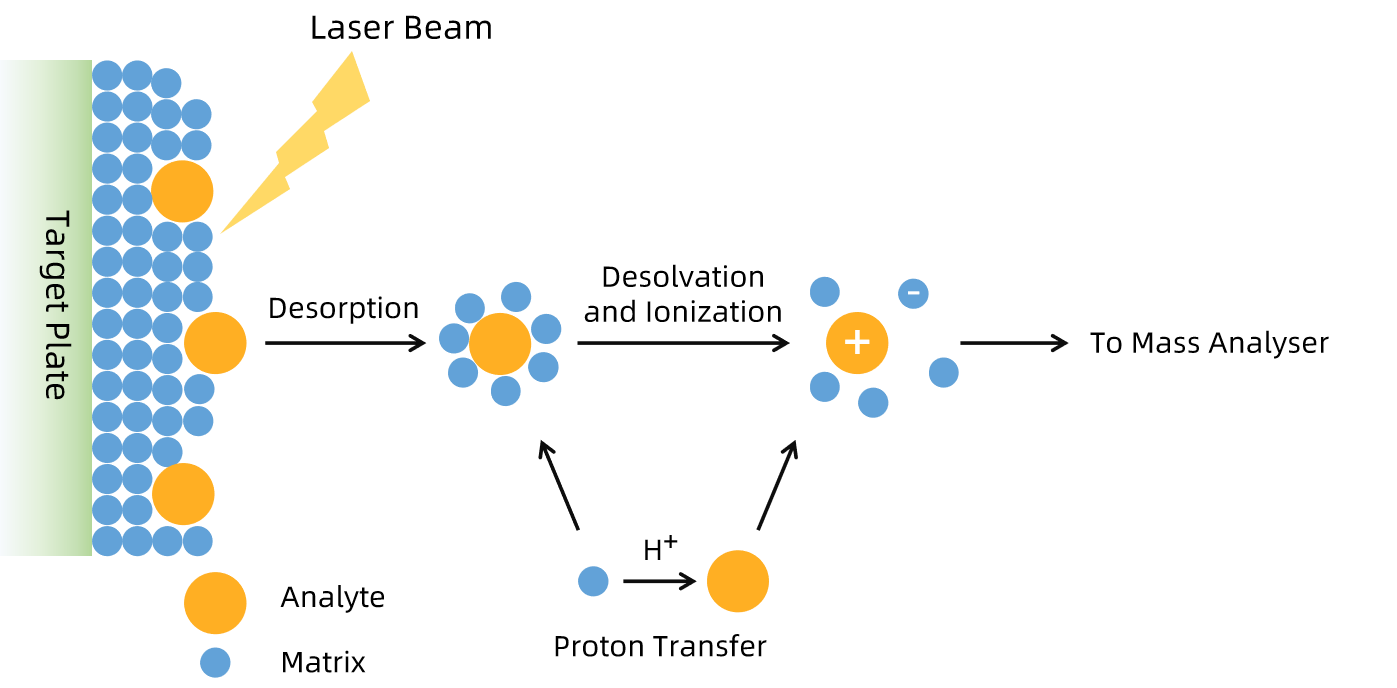MALDI-TOF Mass Spectrometry Service
Mass spectrometry (MS) works by ionizing molecules and measuring their mass-to-charge ratio (m/z) to identify and characterize compounds. MALDI-TOF Mass Spectrometry is a specialized MS technique that uses a laser-activated matrix to ionize samples and a time-of-flight analyzer to determine molecular masses with high accuracy. MtoZ Biolabs offers specialized MALDI-TOF Mass Spectrometry Services that provide precise and reliable data for a variety of applications, including protein identification, characterization of post-translational modifications, and biomarker discovery. Our team of experts tailors the service to meet diverse research needs, ensuring high-quality analysis and helping advance your scientific goals.
Matrix-Assisted Laser Desorption/Ionization (MALDI)
MALDI in MALDI-TOF mass spectrometry is a soft ionization technique that uses a laser-activated chemical matrix to ionize analytes while preserving their molecular integrity. The process involves embedding the sample in a matrix that absorbs laser energy, facilitating the desorption and ionization of molecules into the gas phase for mass spectrometric analysis.

Figure 1. Ionization of Analytes by MALDI
Commonly used laser beams in MALDI include nitrogen lasers (337 nm), solid-state lasers like neodymium-doped yttrium aluminum garnet (Nd:YAG) lasers (355 nm), and frequency-tripled titanium-sapphire lasers (349 nm). These lasers are selected for their precision and compatibility with the matrix-analyte system. Advanced MALDI-TOF mass spectrometry instruments may also use IR lasers (e.g., Er:YAG at 2.94 μm) for specific applications such as tissue imaging.
The matrix in MALDI plays a critical role in facilitating the ionization process by absorbing laser energy, protecting analytes from fragmentation, and transferring energy to generate gas-phase ions. An ideal matrix should co-crystallize uniformly with the analyte, absorb laser energy at the appropriate wavelength, and efficiently transfer this energy to the analyte molecules. The choice of matrix depends on the chemical properties of the analyte, such as molecular weight, polarity, and structural stability, as well as the specific application. The MALDI-TOF Mass Spectrometry Service typically uses matrices such as α-cyano-4-hydroxycinnamic acid (CHCA) for peptides, sinapinic acid (SA) for proteins, and 2,5-dihydroxybenzoic acid (DHB) for small molecules, carbohydrates, and polymers. For specialized applications, 3,5-dimethoxy-4-hydroxycinnamic acid (ferulic acid) is often used for oligonucleotides, 4-hydroxy-α-cyanocinnamic acid amide (HCCA) for glycopeptides, and 2-(4-hydroxyphenylazo)benzoic acid (HABA) for lipids. Additionally, novel matrices like 1,5-diaminonaphthalene (DAN) and 9-aminoacridine (9-AA) are employed for imaging applications and negatively charged analytes, respectively. Selecting the right matrix is essential to ensure optimal desorption and ionization, leading to accurate and high-resolution mass spectrometric results.
Time of Flight Analyzer (TOF)
TOF is a type of mass analyzer in mass spectrometry that separates ions based on their mass-to-charge ratio (m/z) by measuring the time it takes for ions to travel through a flight tube. The principle is straightforward: ions are accelerated by an electric field to the same kinetic energy, and their flight time to the detector depends on their m/z ratio, with lighter ions traveling faster than heavier ones. This provides highly accurate mass measurements over a wide m/z range, making MALDI-TOF mass spectrometry ideal for both small and large molecules.

Figure 2. Schematic for TOF Analyzer
Types of TOF Analyzers and Their Characteristics:
1. Linear TOF: In linear TOF, ions travel through a straight flight tube before reaching the detector. It is simple, fast, and well-suited for high-throughput analyses. However, its resolution is limited compared to other TOF variants.
2. Reflectron TOF: This configuration incorporates a reflectron—a device that reverses the ion trajectory—allowing ions with slight kinetic energy differences to converge at the detector. This increases the resolution and accuracy of mass measurements, making it ideal for applications requiring precise mass determination.
Analysis Workflow

Clark, A. E. et al. Clin Microbiol Rev. 2013.
Figure 3. Workflow for MALDI-TOF Mass Spectrometry Service
The MALDI-TOF Mass Spectrometry Service begins by mixing the sample with a carefully selected matrix that facilitates ionization. The mixture is co-crystallized on a metal target plate and irradiated with a laser beam, where the matrix absorbs the energy, enabling the sublimation and ionization of analyte molecules. The resulting ions are accelerated into a Time-of-Flight (TOF) tube and separated based on their mass-to-charge ratio (m/z), with lighter ions traveling faster than heavier ones. Ion signals are detected and processed by MS software, which generates a mass spectrum. This spectrum is then compared against a reference database to identify the analyte and match it to related spectra. Quality control checks are performed throughout the process to ensure accuracy and reliability.
Applications
1. Proteomics Research
Identify and characterize proteins and peptides for biomarker discovery, functional studies, and post-translational modification analysis using MALDI-TOF mass spectrometry.
2. Clinical Diagnostics
Rapid identification of pathogens, including bacteria and fungi, for infection management and disease diagnosis.
3. Metabolomics and Lipidomics
Analyze small molecules, metabolites, and lipids for understanding metabolic pathways and disease mechanisms.
4. Pharmaceutical Development
MALDI-TOF Mass Spectrometry Service is applied to quality control of drug formulations, stability studies, and the identification of impurities or degradation products.
5. Food Safety and Quality Control
Detect contaminants, verify authenticity, and ensure the quality and safety of food products.
6. Environmental Monitoring
Detect and identify environmental pollutants, toxins, and other contaminants in complex samples.
Why Choose MtoZ Biolabs?
1. Advance Analysis Platform
MtoZ Biolabs established an advanced MALDI-TOF Mass Spectrometry Service platform, guaranteeing reliable, fast, and highly accurate analysis service.
2. One-Time-Charge
Our pricing is transparent, no hidden fees or additional costs.
3. High-Data-Quality
Deep data coverage with strict data quality control. AI-powered bioinformatics platform integrate all MALDI-TOF mass spectrometry data providing clients with a comprehensive data report.
4. Comprehensive Services
MtoZ Biolabs offers a full suite of services tailored to meet diverse research needs.
MtoZ Biolabs, an integrated Chromatography and Mass Spectrometry (MS) Services Provider, provides advanced proteomics, metabolomics, and biopharmaceutical analysis services to researchers in biochemistry, biotechnology, and biopharmaceutical fields. Our ultimate aim is to provide more rapid, high-throughput, and cost-effective analysis, with exceptional data quality and minimal sample consumption. If you are interested in our MALDI-TOF Mass Spectrometry Service, please feel free to contact us.
How to order?







